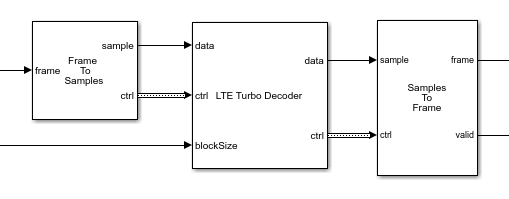Samples To Frame
Convert sample stream to frame-based data
Libraries:
Wireless HDL Toolbox /
I/O Interfaces
Description
The Samples To Frame block reconstructs frame-based data from a stream of samples and its corresponding control signals. It removes any idle or nonvalid samples from the data. See Streaming Sample Interface for details of the streaming format.
Use this block to process output from a subsystem targeted for HDL code generation. This block does not support HDL code generation.
Examples
Verify Turbo Decoder with Framed Data from MATLAB
Verify a hardware-targeted LTE Turbo Decoder design using frames of data from MATLAB®.
Ports
Input
Stream of samples, specified as a scalar or vector. Vector input
values represent a single sample, such as turbo-encoded samples
represented by one systematic value and two parity values. The stream
can include idle cycles between samples and between frames. Idle samples
are discarded. double and single
are supported for simulation but not for HDL code generation.
Data Types: single | double | int8 | int16 | int32 | uint8 | uint16 | uint32 | Boolean | fixed point
Control signals accompanying the sample stream, specified as a
samplecontrol bus. The bus includes the start,
end, and valid control signals, which indicate the
boundaries of the frame and the validity of the samples.
start— Indicates the start of the input frameend— Indicates the end of the input framevalid— Indicates that the data on the input data port is valid
For more details, see Sample Control Bus.
Data Types: bus
Output
Frame of output samples, returned as a column vector. Each frame is the same size. If the input frame is smaller than Output size, the block pads the frame with zeros. If the output frame is larger than the Output size, the block forms the frame by using the first Output size samples. You can optionally output the number of valid samples in each frame on the len port.
Validity of output frame, returned as a Boolean
scalar. This port returns 1 (true)
when the values on the frame and
len (optional) ports, are valid.
Data Types: Boolean
Number of valid samples in output frame, returned as an integer. The input sample stream can have frames of different sizes. The block returns a constant size vector on the frame port, padded with zeros when the input frame is smaller than Output size. The len port indicates how many valid samples are in the output frame. If the output frame is larger than the Output size, the block forms the frame by using the first Output size samples.
Data Types: double
Parameters
Number of values representing each sample, specified as a positive integer
scalar. The block accepts a vector of Input size
values. Each vector has one corresponding set of control signals. For
example, you can use this parameter for turbo-encoded samples. In the LTE
standard, the turbo code rate is 1/3, so each sample is represented by one
systematic value and two parity values: S_n,
P1_n, and P2_n. In this case, set
Input size to 3.
Number of input cycles to buffer before attempting to form an output frame, specified as an integer. The block simulates faster when this parameter is larger. However, the block returns at most one frame from each search window. If more than one frame fits in this window, the block returns the first one it finds and drops the later frames. The default setting, 1 cycle, never drops frames, but results in slower simulation. Therefore, it is a best practice to set this parameter to the minimum number of cycles per frame, including idle cycles.
For example, calculate the valid cycles and idle cycles representing each frame. Each cycle may include more than one sample, depending on your Input size (samplesize) setting.
% Exact setting: includes idle cycles totalframesize = ((framesamples/samplesize)*... (idlecyclesbetweensamples+1))+idlecyclesbetweenframes;
% Conservative setting: number of valid output cycles, without idles
encoderrate = 3;
numtailbits = 12;
framesize = (framesamples+numtailbits)/encoderrate;Maximum number of samples per frame, specified as an integer. The input sample stream can have frames of different sizes. The block returns a constant size vector, padded with zeros if the frame is smaller than Output size. If the block receives a frame larger than Output size, it truncates the frame.
Order of output samples relative to input order, when more than one value
represents each sample. For example, 1/3 turbo-encoded samples are
represented by [S_1 P1_1 P2_1] and [S_2 P1_2
P2_2]. The default output order is [S_1 P1_1 P2_1 S_2
P1_2 P2_2]. To reorder the samples so that systematic and
parity values are grouped together, select Compose output from
interleaved input samples. The output order is then
[S_1 S_2 P1_1 P1_2 P2_1 P2_2].
Enable frame length output port. Select this option to return the number of valid samples in each output frame. The length is returned on the len port and is qualified by the valid signal. Use this option when the sample stream has variable size frames or when a downstream block requires the frame size as input, such as LTE Turbo Decoder.
Extended Capabilities
This block supports C/C++ code generation for Simulink® accelerator and rapid accelerator modes and for DPI component generation.
Version History
Introduced in R2017b
MATLAB Command
You clicked a link that corresponds to this MATLAB command:
Run the command by entering it in the MATLAB Command Window. Web browsers do not support MATLAB commands.
选择网站
选择网站以获取翻译的可用内容,以及查看当地活动和优惠。根据您的位置,我们建议您选择:。
您也可以从以下列表中选择网站:
如何获得最佳网站性能
选择中国网站(中文或英文)以获得最佳网站性能。其他 MathWorks 国家/地区网站并未针对您所在位置的访问进行优化。
美洲
- América Latina (Español)
- Canada (English)
- United States (English)
欧洲
- Belgium (English)
- Denmark (English)
- Deutschland (Deutsch)
- España (Español)
- Finland (English)
- France (Français)
- Ireland (English)
- Italia (Italiano)
- Luxembourg (English)
- Netherlands (English)
- Norway (English)
- Österreich (Deutsch)
- Portugal (English)
- Sweden (English)
- Switzerland
- United Kingdom (English)
